- Joined
- Oct 9, 2007
- Messages
- 47,449 (7.50/day)
- Location
- Hyderabad, India
| System Name | RBMK-1000 |
|---|---|
| Processor | AMD Ryzen 7 5700G |
| Motherboard | ASUS ROG Strix B450-E Gaming |
| Cooling | DeepCool Gammax L240 V2 |
| Memory | 2x 8GB G.Skill Sniper X |
| Video Card(s) | Palit GeForce RTX 2080 SUPER GameRock |
| Storage | Western Digital Black NVMe 512GB |
| Display(s) | BenQ 1440p 60 Hz 27-inch |
| Case | Corsair Carbide 100R |
| Audio Device(s) | ASUS SupremeFX S1220A |
| Power Supply | Cooler Master MWE Gold 650W |
| Mouse | ASUS ROG Strix Impact |
| Keyboard | Gamdias Hermes E2 |
| Software | Windows 11 Pro |
ASRock unveiled its socket LGA1155 motherboard lineup in grand style, showing off eight models, including four value-thru-enthusiast grade motherboards based on the Intel P67 chipset, and four essential-thru-mainstream motherboards based on the Intel H67 chipset. The series is topped by the P67 Extreme6, which packs no less than six SATA 6 Gb/s ports, four external and two internal USB 3.0 ports, three PCI-Express x16 slots, 18-phase CPU VRM making use of high-grade capacitors, and a huge set of connectivity features. Next up is the P67 Extreme4, which is a notch lower than the Extreme6, but it still gives you four SATA 6 Gb/s and four USB 3.0 ports (two external, two internal via header), the same expansion slot layout as the Extreme6, and a slightly slimmer connectivity feature set.
The two Extreme boards are trailed by mid-range ones, starting with the P67 Pro3. The P67 Pro3 has a simple layout and offers not much more than the chipset's feature-set. There are two SATA 6 Gb/s and two USB 3.0 (rear) ports, expansion slots that include just one PCI-Express 2.0 x16, three PCI-E x1, and three PCI. The CPU is powered by an impressive (for this category) 10-phase VRM. Further down the line is the P67 Pro, which is further slimmed down. It does away with USB 3.0 but retains SATA 6 Gb/s. A simpler 4+1 phase CPU VRM is used. Most other features are the same as the Pro3.


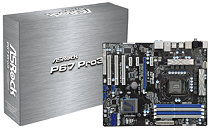

The Intel H67 lineup, where any motherboard manufacturer is expected to sell bigger volumes, begins with the feature-rich H67M GE-HT. This board is made for premium HTPC builds, it offers all the connectivity and media-acceleration features needed. The CPU is driven by a 6-phase VRM, it is wired to four DDR3 DIMM slots for dual-channel memory. The Intel Flexible Display Interface (FDI) is enabled full-on here, with four kinds of display connectors present on board: DVI, D-Sub, HDMI 1.4a, and DisplayPort. Connectivity features include four USB 3.0 (2x rear, 2x internal), 8-channel HD audio with optical SPDIF output, eSATA, gigabit Ethernet; expansion includes two PCI-E x1, one PCI-E 2.0 x16, and a PCI.
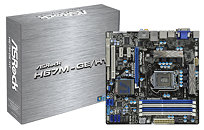
The H67M GE is a stripped down version of the H67M GE-HT. It uses the same PCB, but does away with VRM heatsinks, the internal USB 3.0 ports, and the DisplayPort connector. Next up is the H67M, which is at the bottom of the pile. This retains most of the features of the H67M GE, but uses a narrower PCB, and provides just two DDR3 DIMM slots for dual-channel memory. USB 3.0 and SATA 6 Gb/s are still there. Lastly there's the H67 DE3. This is an ATX board, that provides a feature set similar to the H67M GE, but with more expansion slots: one PCI-Express 2.0 x16, three PCI-E x1, and two PCI. Expect ASRock's boards to be out along with Intel's 2011 Core processor family.
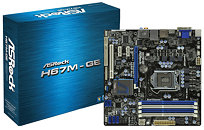
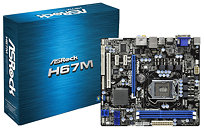
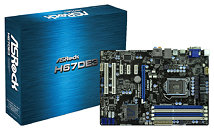
View at TechPowerUp Main Site
The two Extreme boards are trailed by mid-range ones, starting with the P67 Pro3. The P67 Pro3 has a simple layout and offers not much more than the chipset's feature-set. There are two SATA 6 Gb/s and two USB 3.0 (rear) ports, expansion slots that include just one PCI-Express 2.0 x16, three PCI-E x1, and three PCI. The CPU is powered by an impressive (for this category) 10-phase VRM. Further down the line is the P67 Pro, which is further slimmed down. It does away with USB 3.0 but retains SATA 6 Gb/s. A simpler 4+1 phase CPU VRM is used. Most other features are the same as the Pro3.




The Intel H67 lineup, where any motherboard manufacturer is expected to sell bigger volumes, begins with the feature-rich H67M GE-HT. This board is made for premium HTPC builds, it offers all the connectivity and media-acceleration features needed. The CPU is driven by a 6-phase VRM, it is wired to four DDR3 DIMM slots for dual-channel memory. The Intel Flexible Display Interface (FDI) is enabled full-on here, with four kinds of display connectors present on board: DVI, D-Sub, HDMI 1.4a, and DisplayPort. Connectivity features include four USB 3.0 (2x rear, 2x internal), 8-channel HD audio with optical SPDIF output, eSATA, gigabit Ethernet; expansion includes two PCI-E x1, one PCI-E 2.0 x16, and a PCI.

The H67M GE is a stripped down version of the H67M GE-HT. It uses the same PCB, but does away with VRM heatsinks, the internal USB 3.0 ports, and the DisplayPort connector. Next up is the H67M, which is at the bottom of the pile. This retains most of the features of the H67M GE, but uses a narrower PCB, and provides just two DDR3 DIMM slots for dual-channel memory. USB 3.0 and SATA 6 Gb/s are still there. Lastly there's the H67 DE3. This is an ATX board, that provides a feature set similar to the H67M GE, but with more expansion slots: one PCI-Express 2.0 x16, three PCI-E x1, and two PCI. Expect ASRock's boards to be out along with Intel's 2011 Core processor family.



View at TechPowerUp Main Site









 thats right, on the 1st time Asrock launched it just second line of Asus, now Asrock has their own design, nice product and features. it looks better to be that
thats right, on the 1st time Asrock launched it just second line of Asus, now Asrock has their own design, nice product and features. it looks better to be that 